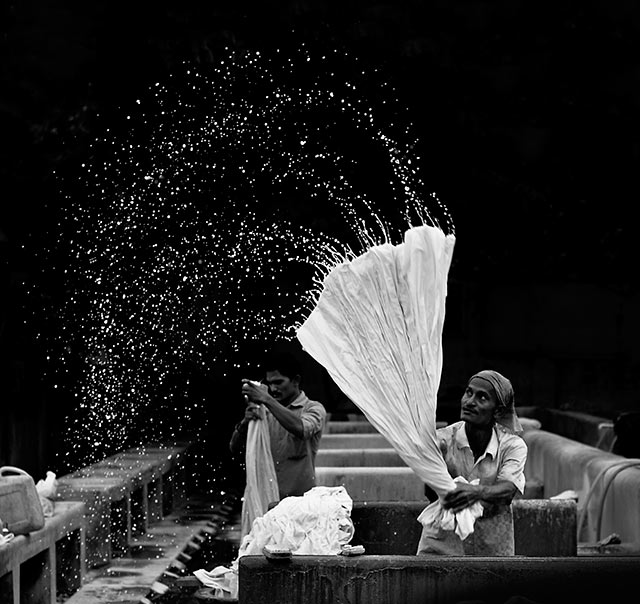Street photography comes in many forms, but all should speak to the viewer in some way. Paying attention to the technical aspects of light, composition and the elements of design are still important, but as a photographer explores the world, they should also attempt to create images that tell a story, grab our emotions or convey some insight about the world in which they live.
G. Krupa accomplished it all by sharing with us his vision of his surrounding within just one second in time.
Mr. Spinnerby G. Krupa Sindhu

© 2013 G. Krupa Sindhu. All Rights Reserved.
Subject: A Dhobi (people who wash, dry and press clothes) at work in Chennai, Tamil Nadu, India
Conditions: “This image was made on a morning photo walk to a Dhobighat, where people wash the clothes. It’s a common practice of spinning the soap soaked clothes with force and then hitting then on a stone to get rid of the dirt.”
Composition:
1. Strength in black & white simplifies the image
2. Diagonal implied lines of motion
3. Arc of water spray – shows action and frames another worker
4. Lines of washing stations frame men working
5. Low-key lighting
6. A cultural story of life is being conveyed
Noella’s Comments:
Conversions from color to black and white can emphasize the drama and dynamics of a composition. There is strength in the limited palette of black, minimal tones of gray and stark white. And a part of that strength is in the way it simplifies the image. The many nuances of color are stripped away and the image is reduced to a basic tonal statement. When done really well, as it was in this image, the effect can be stunning.
When reviewing the composition of this photograph, look at the eyes of the man flipping the sheet and follow his line of sight. It creates an implied diagonal line that leads the viewer across the image frame and emphasizes the arc of the sheet and water. And the diagonal lines within the sheet itself lead to the hands and spray. All provide the viewer with a distinct sense of motion.
G. Krupa positioned himself so when the spinner flung the sheet it created an arc that surrounds another worker. This not only makes a compelling frame around that worker, but adds depth to the image.
The many lines of the washing stations also keep the center of interest focused on the men and the laundry. Notice how the lines move to a spot on the horizon in a diagonal and how those lines keep you entrapped within the frame of the composition. No matter how you try, your eye cannot escape and wander away from the subject for very long.
In this low-key image the quality of light adds to the impact by highlighting the laundry, the spray and the man. The background disappears into blackness, so again the image is simplified into one action and one moment in time. As the cultural story of life ina Dhobighat in India is portrayed, one is left to wonder and imagine the entire process from start to finish.
This is an outstanding image and we thank G. Krupa for sharing his image and his vision with us and allowing us to share it with all of you.

Leave a Reply